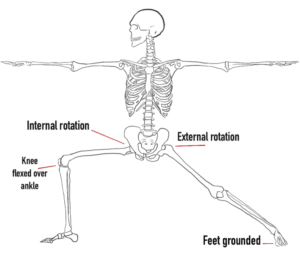This pose is a powerful grounding asana that forms the foundation on which we build so many of the other standing poses. Building up our ability to holding Virabhadrasana B helps you to work not only on balance and muscle strength, but also gives you a chance to focus your mind when the heat of sustaining the pose builds.
Virabhadrasana B has a wide stance with right foot and leg externally rotated and left foot turned inward, placed at 90 degrees of the right foot. Arms abducted away from the body using the deltoids and supraspinatus to hold at shoulder level. The latissimus dorsi and parts of the deltoids hold the internal rotation of the arms. The arms are stabilsed when they extend by the pectorals.
 As you hold the pose the spinal extensors and transversus abdominis extend and maintain the spine. The scapula retracts downward with the help of the rhomboids and trapezius muscles.
As you hold the pose the spinal extensors and transversus abdominis extend and maintain the spine. The scapula retracts downward with the help of the rhomboids and trapezius muscles.
The front leg is held in the active lunge with the help of the hip flexor muscles and the hamstrings which flex and hold the knee stable.
Building strong proper alignment for Virabhadrasana B helps to reduce the risk of damage to knees through over extension, hyperextended shoulders and lower back and pelvis pain that from not holding the pelvis in a neutral position.
Make sure that the knee is aligned over the heel, and crawl the toes forward or move back foot back if needed. Check alignment of sitting bone and the Sagittal plane to looking for equal weight distribution. Also check along the anterior and posterior planes for alignment of head, spine, hips. Shoulder blades should be down and back with face turned over the right knee.
To come out of the pose, push through the feet and rise up, release the arms to your side.
Namaste

